Two neighbouring paths under Kennedy Bridge in Girgaum, Vitthalbhai Patel Road and Procter Road, reveal startling contrasts and confluences
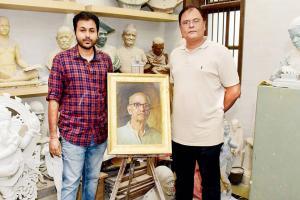
Fourth-generation sculptor Gaurang Talim with father Rajiv at the studio his great-grandfather BV Talim (in portrait) set up on VP Road
 What's in a name? Much, in an area as variously referred to as Kennedy Bridge, Pavan Pul or Congress House. Tell a cabbie "Kennedy Bridge" and he says "Pavan Pul bolo na." Asking for Congress House, I hear "Aap Shapur Baug jayenge?" He has decided I must live in this Parsi enclave off Grant Road.
What's in a name? Much, in an area as variously referred to as Kennedy Bridge, Pavan Pul or Congress House. Tell a cabbie "Kennedy Bridge" and he says "Pavan Pul bolo na." Asking for Congress House, I hear "Aap Shapur Baug jayenge?" He has decided I must live in this Parsi enclave off Grant Road.
Kennedy Sea Face (Marine Drive) is named for Lieutenant Colonel Michael Kavanagh Kennedy who served in the Engineers in Bombay. Kennedy Bridge, however, is for John Pitt Kennedy, Government Railway Engineer in 1850.
ADVERTISEMENT
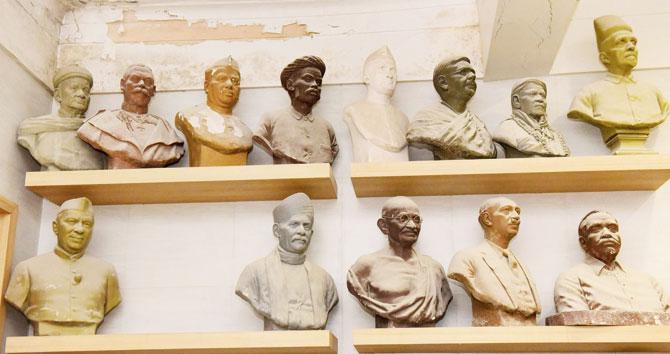
Saadat Hasan Manto called this Pavan Pul—Bridge of Breeze. The Urdu author was windblown walking from Byculla, where he lived, to Nana Chowk, where he worked at Jyoti Film Studio for Ardeshir Irani, director of the first talkie. In 1937, Manto wrote Kisan Kanya for Irani, the first indigenously processed film. The colourful mujra dancers' kothas around Congress House featured in his story Haarta Chala Gaya.
Vitthalbhai Patel Road (after Sardar Patel's elder brother, co-founder of the Swaraj Party) and Procter Road (Sir Henry Procter headed the Bombay Chamber of Commerce) skirt the bridge. Their churches and chawls share walls with a pell-mell patchwork of auto parts dealers and noisy nautch rooms. Ghungroo bells clinking, tawaifs sang from 8 pm at mehfils in the compound below. "This was the 1950s-60s' taboo neighbourhood," critic Khalid Mohamed said when he scripted Kennedy Bridge, watching moist-eyed as his life unfolded on stage.
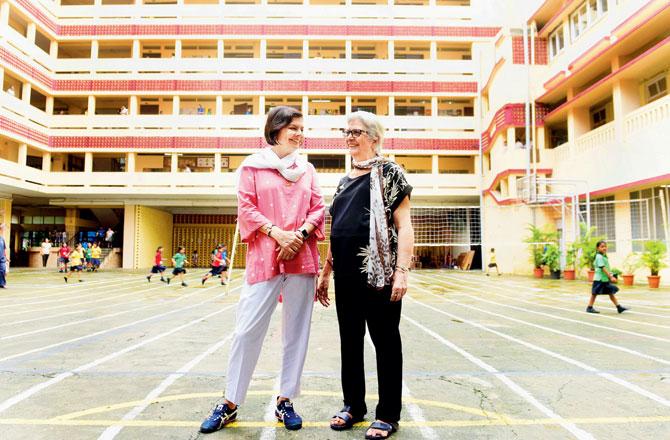
Filmmaker Sooni Taraporevala at Queen Mary's School with her former principal Rati Wadia
Pinning her hair with mogras she has haggled for, a sex worker says, "Our manager madam provided girls for thumka steps in movies. Koi kaafi tiptop angrez filmwale Pavan Pul aaye thay, 1980s mein." Could she mean Merchant-Ivory shooting their documentary, The Courtesans of Bombay?
In the paper, "One Space, Many Stories: Congress House and the Courtesans of Bombay", Geeta Thatra of Jawaharlal Nehru University notes: "I explored parallel histories between these apparently paradoxical spaces. Drawing on the political role of collective memory and reconstructing the history of mujra performances, I posit that Congress House and the compound evolved simultaneously in mutual coexistence during the early 20th century."
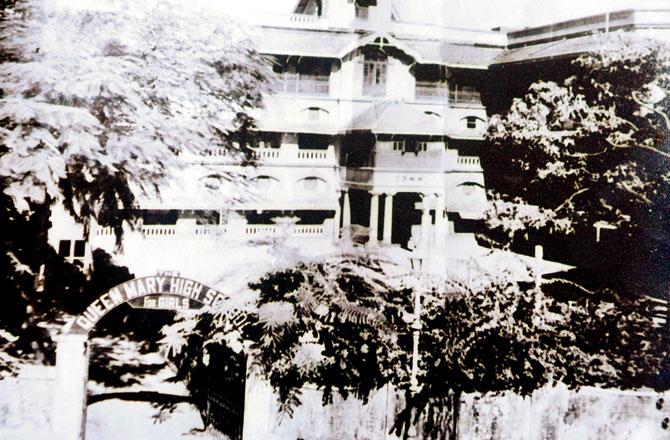
The school's original building with a gable, front porch and open verandas
Before pop remixes ruled as raucous entertainment, these kothas hosted classical concerts with Hindustani vocalists and tabla maestros. The rust-caked signboard of Mumbai Sangeet Kalakaar Mandal, established in 1972 by Indira Gandhi, overlooks a canopied balcony at Congress House's entrance. "Shehnai accompanists sat there for flag hoisting on days of national significance," says Nayan Yagnik, chairman of the Bombay Pradesh Congress Committee Properties Trust.
Yagnik's office is in 1910-erected Vitthal Sadan, oldest among the cluster of Tilak Mandir, Sarojini Sadan, Kasturba Kutir, Dadabhai Manzil and Jinnah Hall. Headquartering the INC city unit, Congress House birthed the Civil Disobedience and Quit India movements, with Gandhiji and his supporters charting protests. "I came here as a three-year-old with my father Bhanushankar, jailed repeatedly in the 1930s till the 1942 August Kranti," Yagnik recalls.
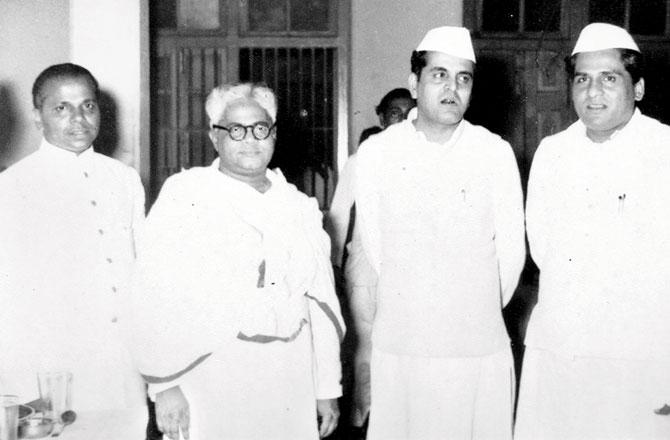
At Congress House around 1960: GP Nair, Bhanushankar Yagnik, Atulya Ghosh and RS Pandey
Jinnah Hall rose with public subscriptions, in victory over colonial clout. Muhammad Ali Jinnah led the campaign thwarting Lord Willingdon's intent of a memorial to himself. Who would know though? The Shiv Sena has destroyed a plaque marking "the triumph of democracy under the brilliant leadership of MA Jinnah".
A few feet from Congress Restaurant stands a nearly 150-year-old institution. "I've spent a lifetime at the best school anyone is privileged to be a student at, a teacher and a principal," says Rati Wadia of Queen Mary's, where Sharada Dwivedi, Sooni Taraporevala and Shabana Azmi were pupils. It was opened in 1875 as the Bombay Indian Female Normal School, by Harriet Butt of the Zenana Bible Medical Mission in Byculla. Relocating as the Girgaon Girls High School, this was rechristened in 1892 after the Queen Empress laid the foundation for its hall.
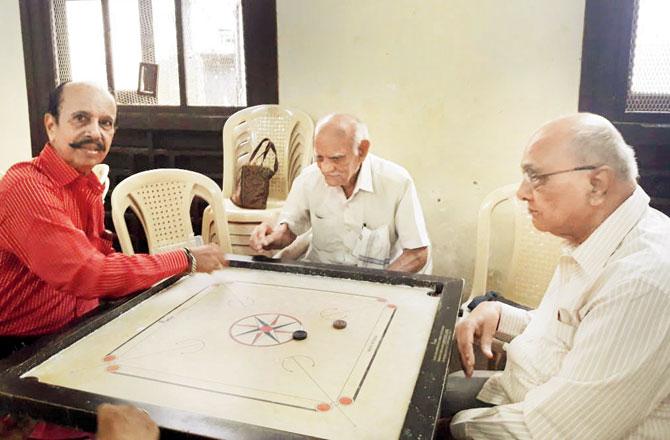
Chunilal Panchal, 102 (centre), strikes a shot at the carrom board. The ex-wrestling judge walks every evening from his Tardeo home to the senior citizens' centre on Procter Road
To quote from The Maharani's Locket, an account in the Queen Marian magazine by the school's legendary principal, Betty Shelton: "In Bombay, two English nurses gave maternity care and even occasional lessons to secluded girls longing to be literate. One attended on a Maharani during a complicated childbirth. The nurse was going on home leave. The Maharani handed her a locket, instructing that it be handed over to Queen Victoria. When the nurse tried explaining she could not just see the Queen, the Maharani said her subjects could speak to her, so the nurse had to find some way of meeting the Queen.
"Back in the UK, Trust members helped fulfill her assignment. In that locket was a personal request to Victoria to train women for medical studies, as suffering females were not permitted male doctors. The Maharani's SOS was heeded, women were allowed into UK universities. Of the first six lady doctors, four landed up serving their sisters in India. The Blind School for Women started in Dehradun, orphanages in West India at Manmad and Sholapur. Bombay children began learning in zenanas and eventually in a central quarter. Lady teachers arrived to run the prototype of our School."
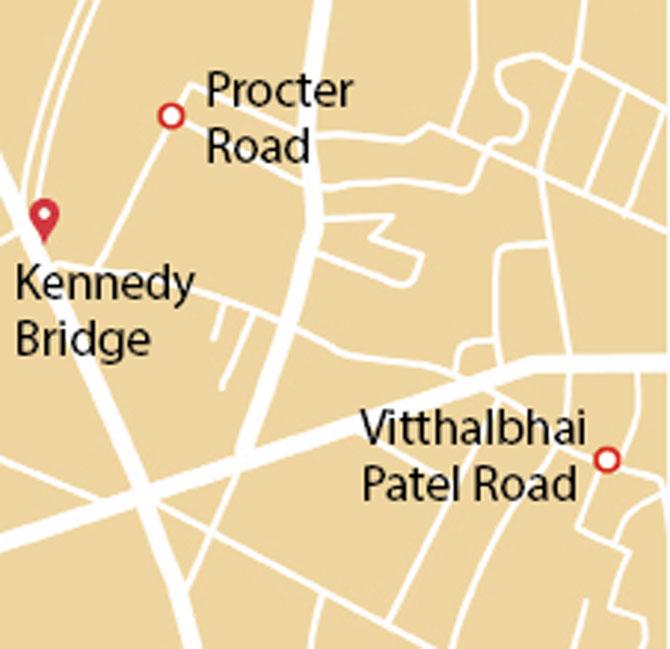
Map/Uday Mohite
No one trod a shorter route to work than the two-minute distance Rati Wadia did to Queen Mary's from her Shapur Baug flat. "I'm born, bred and have lived 77 years in this colony, also home to dancer Astad Deboo and violinist Siloo Panthaky who played with Yehudi Menuhin." I accompany Wadia to Dinoo Damania's block, across hers, where the "friends-from-age 2" enjoy a simple potluck dinner together daily.
Damania warms to recollections of growing up in the 1939-built baug: "We had fun at our doorstep which kids now have no idea of, that's their big loss. Picnics, jashans, fairs, stilt-walking, roller-skating, sports and…" She trails off as Wadia exclaims "Drama!" flourishing a sepia-browned photo of her father, Dara Vania, dressed for a woman's role.
Shapur Baug residents hardly have a monopoly on devotion to next-door Aslaji Bhikaji Agiary. The faithful countrywide flock to the 1860s fire temple. "Aiyya baddhi mushkil aasaan thaay, all problems ease here," says priest in charge Dasturji Nariman. Serpentine queues of believers bearing sandalwood sticks coil on auspicious dates like Meher roj in the Zoroastrian calendar month. On the eve of Muktad—the 10 days of prayer for departed ancestors before Navroze dawns—silver flower vases and fruit platters gleam softly on long marble tables.
A pit stop near the Baug gate gets me chatting in Ezzad Cold Drink House with Azam and Mohammad Dabir. Their customers for bread, eggs and wafers being mainly Parsi, the brothers have framed a Zarathushtra portrait.
A slant across, worshippers of every community bow at Sai Dham. A dream visitation from the Shirdi saint inspired Balaji Vasantrao Talim to carve his mud clay statue in gratitude and set up Talim's Art Studio on VP Road in 1918. "With Baba's blessings he chiselled busts in bronze, plaster and metal, of warriors, patriots and philanthropists like Jamsetji Tata," says BV Talim's grandson Rajiv.
On Procter Road, the Anandashram Housing Society, well-maintained since 1937, is named after the ninth guru of the Chitrapur Saraswats. Picture-pretty in stone, a little ahead lies Gothic-styled, 1869-built Emmanuel Church. It faces Church Mission House, offering travellers affordable accommodation. Wigram Hall beside appears deserted till the Dignity Foundation's senior citizens group mid-evening for games and gossip. Striking firm-fingered carrom shots, 102-year-old Chunilal Panchal insists he's spry thanks to years of hockey and wrestling practice.
Opposite the Robert Money Technical Institute, much after Kennaway House was no more a soldiers' infirmary, an interesting resident moved in. The feisty 1960s-70s' film journo Devyani Chaubal aka Devi, famous for launching Rajesh Khanna. Eyes loaded with kohl, pen with vitriol, she wrote the Star & Style column, Frankly Speaking. With her white organza sari hitched high at a fundraiser, she once ran to dodge a drunk Dharmendra, livid about an item on his love life.
At Model House, several creative personalities happen to have lived in its Block D—actress Bhakti Barve, singer Suman Kalyanpur and Marathi theatre's MG Rangnekar, who directed Toh Mee Navhech radically for 1962, with half the stage a courtroom while the other depicted an actual enactment of what the witness described. Labour champion NM Joshi, who formed the Social Service League in 1911, shifted into Model House on retiring from the Servants of India Society.
Another forgotten hero, Dr Dwarkanath Kotnis, passed away in China in 1942 before his family came to Model House. Remember V Shantaram's Dr Kotnis ki Amar Kahani? The youngest of four medicos India had sent to aid the Chinese against Jap invasions of 1937, Dr Kotnis alone stayed back. He succumbed on the warfront to an epileptic episode. Dr Sumangala Kotnis Borkar, a niece, says, "In his second MBBS year at KEM, he opposed a pro-British dean replacing Dr Jivraj Mehta. Expelled for outspokenness, he finished from Grant Medical College. Years after he died, his Chinese wife celebrated their son's 16th birthday at Model House."
Bouquets still pile at Dr Kotnis' tribute monument in Shijiazhuang. In Madame Sun Yat Sen's words: "His memory belongs not only to your people and ours, but the rollcall of fighters for freedom and progress of all mankind. It was for the future that he struggled."
Author-publisher Meher Marfatia writes fortnightly on everything that makes her love Mumbai and adore Bombay. You can reach her at mehermarfatia@gmail.com/www.mehermarfatia.com
Catch up on all the latest Crime, National, International and Hatke news here. Also download the new mid-day Android and iOS apps to get latest updates
 Subscribe today by clicking the link and stay updated with the latest news!" Click here!
Subscribe today by clicking the link and stay updated with the latest news!" Click here!







